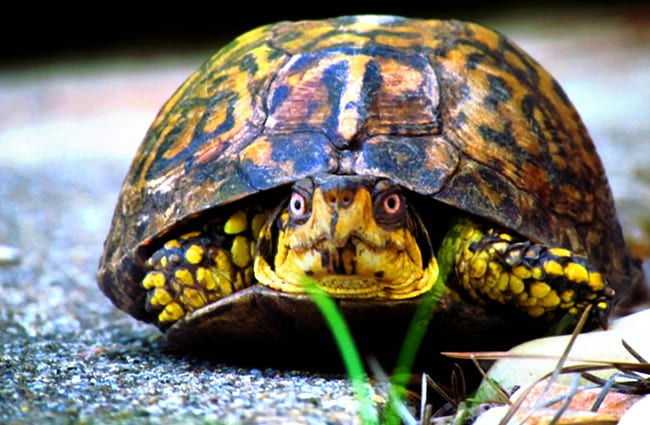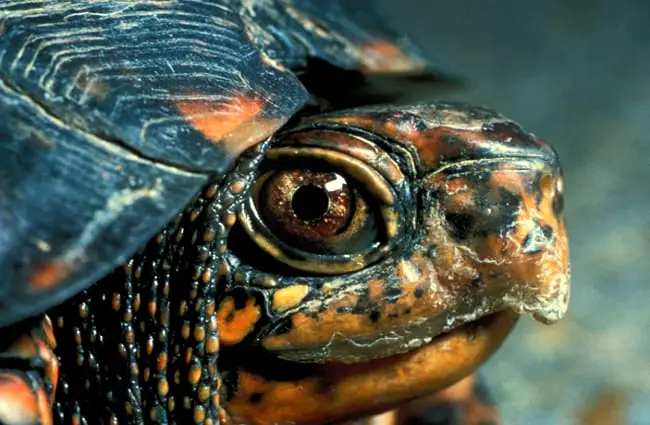Box turtles are a group of turtles that live in North America. There are several different species of box turtles, including the common, Coahuilan, Mexican, spotted, and ornate box turtle.
These creatures are one of the few turtles that do not swim in the water. In fact, they are much more like tortoises than other turtles. Read on to learn about the box turtle.
Description of the Box Turtle
As previously mentioned, box turtles look and behave more like tortoises than turtles. Unlike aquatic turtles, which have flattened and streamlined shells, box turtles have tall domed shells. Their exact appearance varies by species.
Some box turtles have dark shells with yellow patterns, others have spots or speckles, and others are solid colored. These turtles range in size from about five inches long to seven inches long.
Interesting Facts About the Box Turtle
Box turtles are unique little creatures, and they differ from other turtles in a few ways. Learn about some of their adaptations and traits below.
- Tortoise-Like Turtle – The vast majority of box turtles stay well away from water. They are unique in the turtle world in this respect, and this behavior makes them much more like tortoises. There is, however, a single aquatic species of box turtle; the Coahuilan box turtle.
- Sealed Box – These turtles have the uncanny ability to seal themselves inside their shell. When threatened, they withdraw and close the opening using a hinge in their shell. This keeps them safe from most predators, though smaller turtles have softer shells.
- Unique Trait – The ability to seal their shell is actually incredibly unique amongst turtles. In fact, you only see this in some species of tortoise. Most turtles and tortoises use their tough legs to block the opening to the shell.
- Shell Structure – The top half of the shell is the carapace, and the bottom half is the plastron. The turtle’s backbone is actually fused to the inside of the carapace. This means that turtles cannot ever leave their shells.
Habitat of the Box Turtle
These reptiles live in a variety of different ecosystems, particularly in different regions. Habitat preference varies from species to species, subspecies to subspecies, and even individual to individual.
They live in hardwood forests, grasslands, marshes, riverbeds, meadows, and more. These reptiles prefer living in temperate regions that are not too cold, but not too tropical either.
Distribution of the Box Turtle
Different species and subspecies of box turtle live across North America and parts of Central America. Their range extends as far north as Maine, and as far south as Florida in the United States.
From the east coast, various species range all the way to Arizona, Colorado, and Wyoming. They also spread south into Mexico, primarily along the eastern coast and northern regions.
Diet of the Box Turtle
These turtles are omnivores, which means they eat plants and animals, usually insects and invertebrates. Some of their favorite prey includes crickets, grasshoppers, worms, spiders, centipedes, snails, and other small creatures.
The vegetarian portions of their diet usually consist of berries, fruits, grasses, cactus, and more. For the most part, they are opportunistic, and feed on just about anything that they can find and catch.
Box Turtle and Human Interaction
Outside of the pet trade, these turtles rarely benefit from human interaction. Habitat destruction is devastating to some species, and cars are an obvious nemesis to their otherwise impenetrable shells.
These turtles also become disoriented when otherwise well-meaning humans take them as pets and release them elsewhere. Sadly, human interaction has caused some populations to decline. The IUCN lists the eastern box turtle as Vulnerable, and the Coahuila as Endangered.
Domestication
Humans have not domesticated box turtles in any way.
Does the Box Turtle Make a Good Pet
Yes, some species of box turtles are good pets. However, many populations are decreasing, so you should always choose a pet that was born in captivity. It is also important to never release a pet into the wild, because it could spread disease to the wild population.
Box Turtle Care
Like all turtles, box turtles need a light source and a heat source to thrive. You should choose your setup at the discretion of your breeder or veterinarian. These turtles prefer a varied diet, with a mixture of insects, fruits, and vegetables.
Like most reptiles, you should only handle them gently and carefully. Rough or overly frequent handing increases stress and thus makes them more susceptible to illness.
Behavior of the Box Turtle
Like most reptiles, box turtles prefer living alone, and are solitary creatures. They have territories, and usually stay within these territories while searching for food.
When threatened, these turtles simply withdraw into their shells and wait for the predator to give up. For the most part, their shells are strong enough to withstand most predators, though younger animals are more vulnerable.
Reproduction of the Box Turtle
These small turtles lay small eggs, usually in nests beneath the ground or under vegetation. Younger animals have smaller clutches of eggs, while older animals usually lay up to seven eggs. Their egg laying also depends on how much food was available to them that season.
The young hatch from their eggs after several months, depending on the temperature. Hatchlings are fully independent, and strike off on their own when they hatch.











![Red Angus Closeup of a beautiful Red Angus cowPhoto by: U.S. Department of Agriculture [pubic domain]https://creativecommons.org/licenses/by/2.0/](https://animals.net/wp-content/uploads/2020/03/Red-Angus-4-238x178.jpg)












![Red Angus Closeup of a beautiful Red Angus cowPhoto by: U.S. Department of Agriculture [pubic domain]https://creativecommons.org/licenses/by/2.0/](https://animals.net/wp-content/uploads/2020/03/Red-Angus-4-100x75.jpg)

